Physical Address
304 North Cardinal St.
Dorchester Center, MA 02124
Physical Address
304 North Cardinal St.
Dorchester Center, MA 02124

Discover 23 expert furniture ideas to design a living room that thrives. Learn to create a functional, beautiful, and plant-filled sanctuary with purpose and style.
A confession: I used to think designing a room was just about finding beautiful things and putting them in a beautiful order. Then, I killed a magnificent six-foot Ficus lyrata.
It wasn’t a pest or a disease. It was bad design. I had placed it in a spot that looked perfect in a magazine photo but starved it of the morning light it craved. I learned the hard way that a room isn’t a static showroom. It’s an ecosystem. And your furniture? It’s the architecture of that ecosystem. It’s the trellis for your life, the canopy for your comfort, and the structure that determines whether everything in it—you, your family, your plants—will truly thrive.
So let’s talk about creating a living room. Not just decorating one. This isn’t about chasing trends; it’s about cultivating a space that breathes. Here’s how we build that foundation.
Before you buy a single thing, we have to survey the land. This is the part everyone wants to skip, and it’s the only part that actually guarantees you’ll love the final result. It’s about understanding the environment—the light, the flow, the needs of its inhabitants—before we start planting.
You know what people always ask me? “Will this sofa fit?” And my answer is always another question: “Have you met my friend, blue painter’s tape?” Forget just measuring the walls. I want you to go a step further. Once you find a sofa you like online, get its dimensions (say, 84″ long by 38″ deep) and tape that exact rectangle onto your floor. Now, live with it for a day.
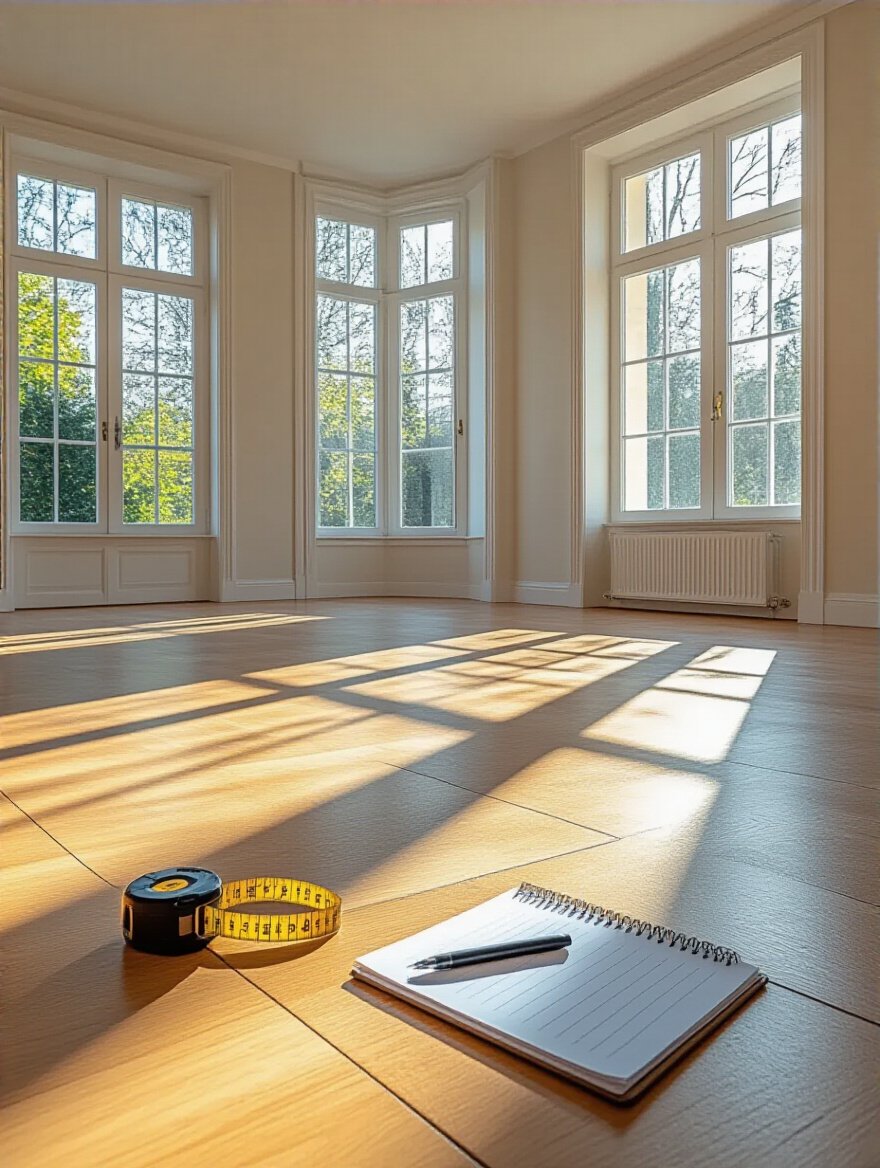
Walk around it. See how it feels. Does it create a natural pathway to the window where your bird of paradise needs to be? Does it leave enough room for your aroid collection on the floor? This simple act of visualization stops you from making the costliest mistake: buying furniture that theoretically fits the space but practically suffocates it. The numbers on a tape measure are just data; the tape on the floor tells the real story of how a room will live and breathe.
From the macro-environment, we zoom in to the personal biome you want to create.
Can we talk about why everyone gets “style” wrong? They scroll Pinterest, find a photo labeled “Modern Farmhouse,” and then buy a bunch of things that fit the label. It’s a recipe for a room that feels hollow and, frankly, a bit like a movie set. A real home isn’t a label; it’s an emotional biome. So before you shop, ask yourself: How do I want to feel in here?
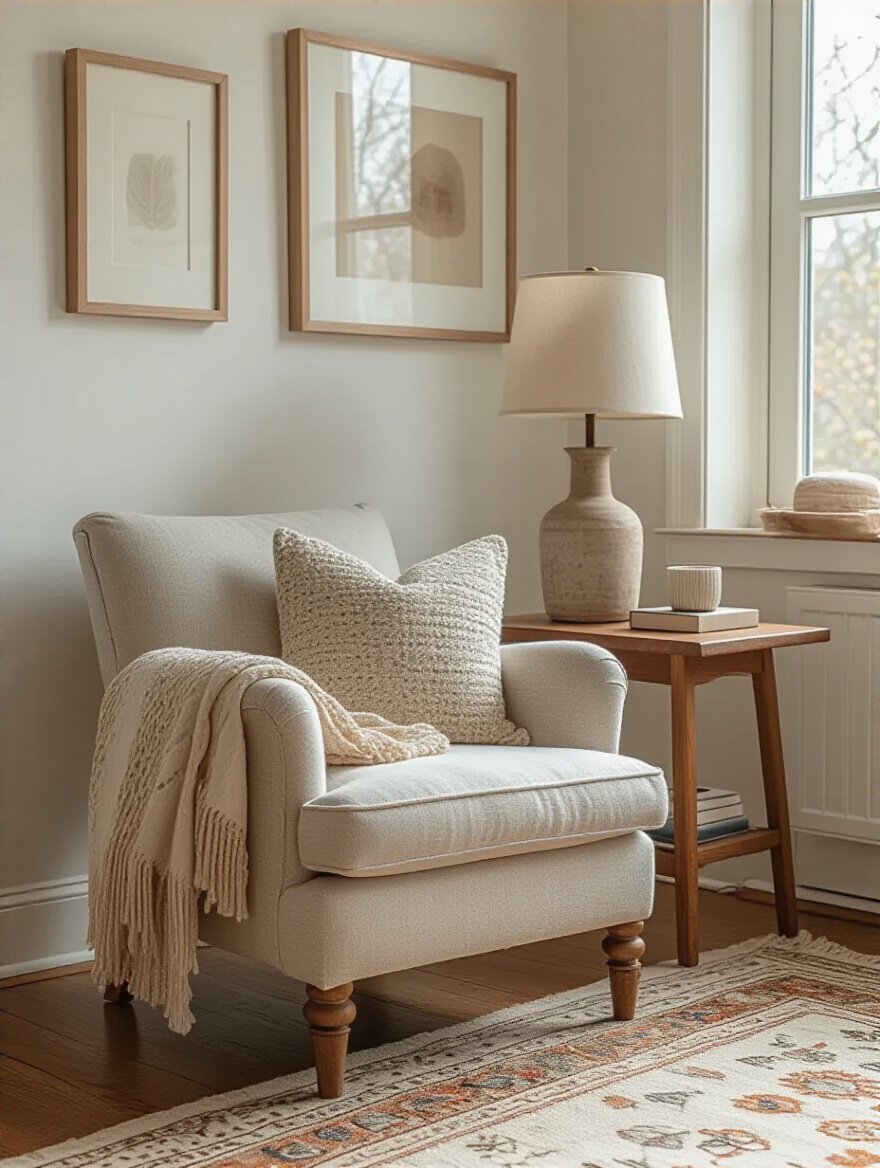
Do you crave the feeling of a sun-drenched greenhouse, airy and bright? That points you toward lighter woods, leggy furniture, and natural fibers like linen and rattan. Or maybe you want a moody, cozy den, like a forest floor after the rain? That suggests deep velvets, dark woods, and a rich, grounding color palette. Forget the official “styles.” Define your room’s core feeling, its climate. The right furniture will naturally follow.
And that feeling needs to be supported by a smart allocation of resources.
Here’s the BS line everyone’s heard: “Invest in quality, it’s worth it.” It’s not wrong, but it’s dangerously incomplete. You don’t need to invest in everything. Think of it like a garden. You spend the real money on the foundational “tree”—the thing you’ll interact with every single day. For a living room, that’s your sofa. That’s where you put the bulk of your resources, because its frame, springs, and fabric will determine your comfort for a decade.

For the “annuals”—the side tables, the throw pillows, the decorative accents—you can be far more frugal. These are the pieces that can be easily swapped out as your taste evolves or as they get worn. The big shortcut here is the high-low mix. Splurge on the sofa. Be savvy on the accessories. That’s how you build a room that feels luxurious and personal without going into debt.
Now that we know the lay of the land, let’s map out the trails.
In nature, you see them everywhere: desire paths. The worn-down trails in the grass that show where people actually walk. Your living room has these too, even if it’s empty. They are the invisible lines connecting the doorway to the sofa, the sofa to the window, the armchair to the bookshelf. Your job is to find them and keep them clear.
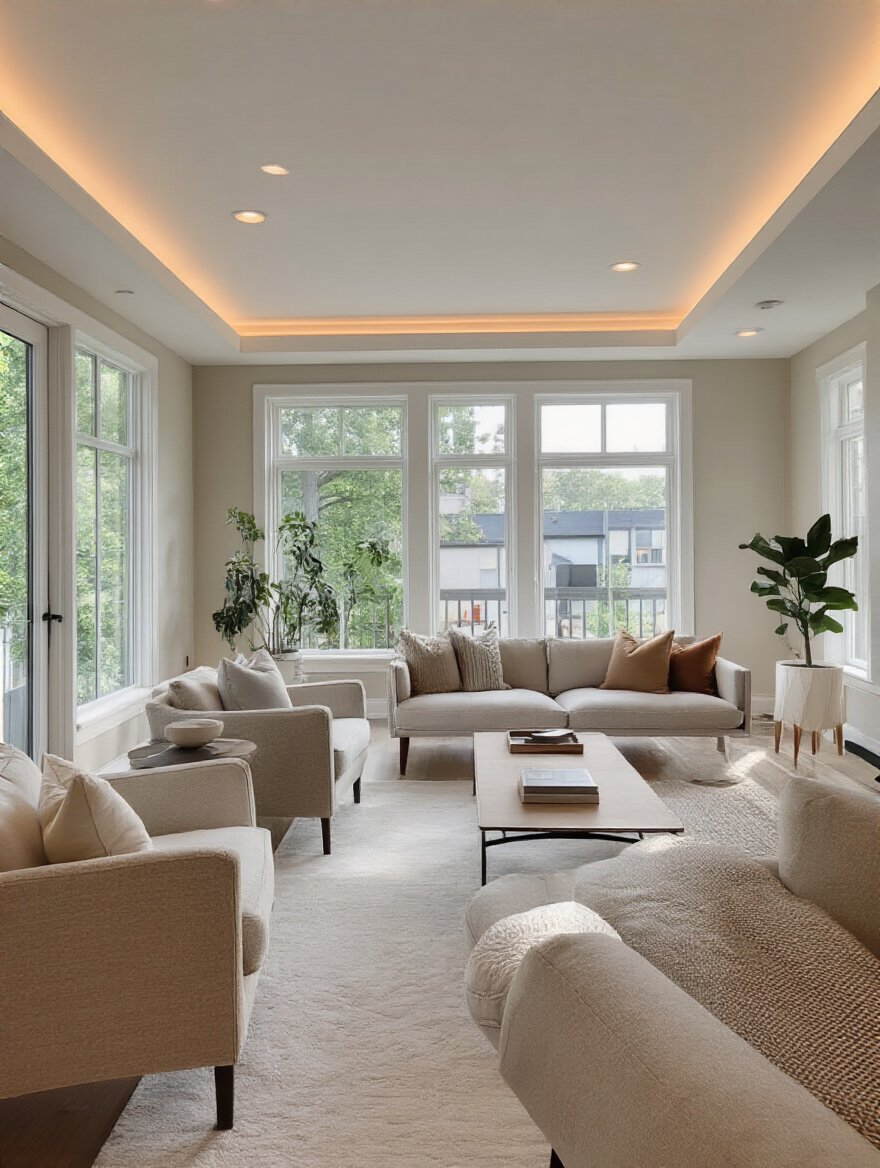
Before you arrange anything, stand in each doorway and imagine walking to the most logical destinations in the room. You need a bare minimum of 30-36 inches for these main arteries. If a piece of furniture infringes on that path, it’s a non-starter. A common mistake is creating a layout that looks beautiful from one angle but forces you to shimmy sideways to get to your favorite reading chair. A room that obstructs movement is a room that creates subconscious stress, and it’s a death sentence for any floor plants you try to keep along those crowded paths.
Once the paths are clear, we need to know what we’re actually doing in here.
The most beautiful, hand-crafted Italian sofa in the world is useless if your family’s main activity is building LEGO castles on the floor and eating pizza while watching movies. Your furniture must serve your life, not the other way around. Be ruthlessly honest about what you do in this room. Is it mostly a serene sanctuary for you and a book? Then a deep, comfortable chaise and good task lighting are your priorities.
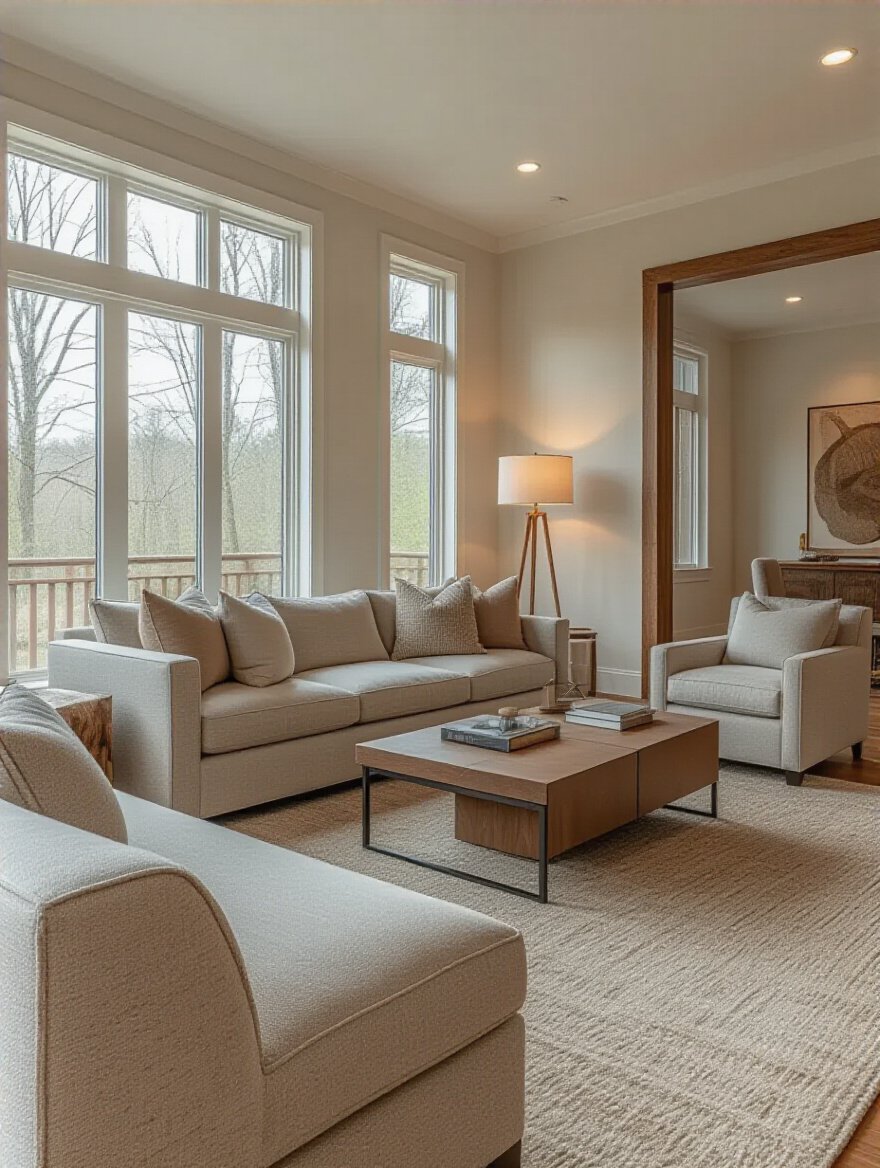
If it’s a bustling hub for kids and pets, your non-negotiables are a durable, stain-resistant sectional and a soft-edged ottoman that can double as a building surface and toy chest. Forget what you think a living room should have. Focus on what your living room needs to support your daily habits. That’s the shortcut to a room that feels effortlessly useful instead of a museum you’re afraid to touch.
This brings us to the backdrop that will tie all these functional choices together.
Think of your color palette as the sky. It sets the entire mood for the landscape below. You don’t need a PhD in color theory; you just need to look at nature. The most serene and timeless environments often have a very simple, dominant color—the soft beige of a sandy beach, the muted green of sagebrush, the cloudy grey of an overcast sky. This becomes your neutral foundation.

Your sofa, your rug, your walls—they should all live within this dominant color family. The vibrant color, the real life, comes from the accents. The deep, living green of your plants. The terracotta of a clay pot. The rich blue of a single throw pillow. People go wrong when they try to make every piece of furniture a “statement.” Let your foundation be calm and cohesive, and then use your plants and small decor as the pops of life that bring the whole ecosystem into focus.
With the blueprint in place, we can start bringing in the big players. This is where we select the anchor pieces that form the very structure of our indoor ecosystem—the canopy trees and the understory shrubs that define how the space feels and functions.
The sofa is the main canopy tree of your living room. It’s the anchor. And the number one mistake I see is people buying one that’s too big, with huge, puffy arms that devour precious square footage. But an equally bad mistake is forgetting to measure the journey, not just the destination. I once had a client fall in love with a custom sofa, only to have the delivery guys stand in their narrow hallway, shaking their heads. It wouldn’t make the turn. A $5,000 mistake.
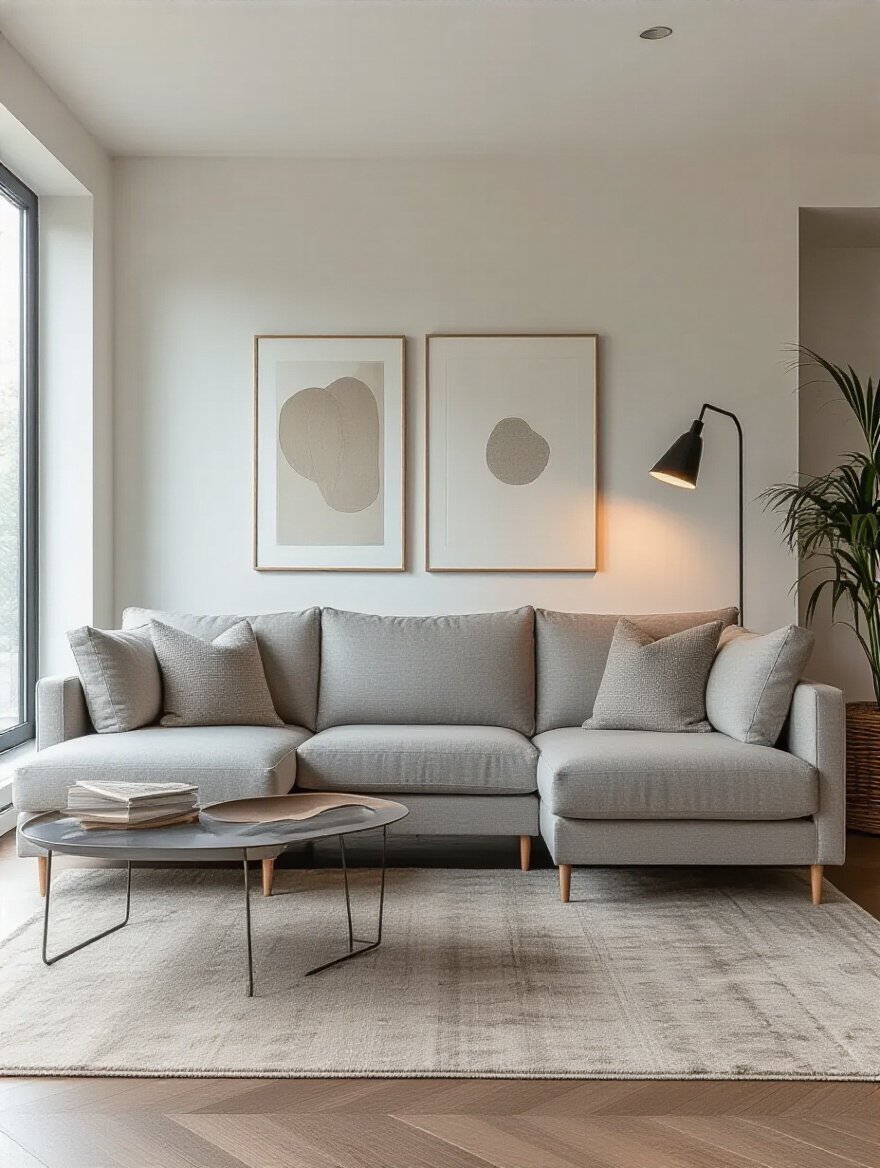
The shortcut? Before you buy any large piece of furniture, measure every doorway, every hallway, and every stairwell it has to pass through. And when choosing a style, look for “visual weight.” A sofa on slender legs with slim track arms feels infinitely lighter and more open than a blocky one that sits directly on the floor, even if they have the same footprint. In a small space, that visual lightness gives the room—and your plants on the floor—space to breathe.
Once the big tree is in place, you need to arrange the rest of the forest to encourage community.
Have you ever been at a party where you had to shout across a vast coffee table to talk to someone? It’s awkward because it violates a basic principle of human biology. We’re wired for connection at a specific distance—ideally, no more than about 8 feet apart for comfortable conversation. Any further, and the social bond starts to fray. The same is true for your furniture.

So, forget placing all your furniture against the walls like it’s a middle school dance. Pull your seating in. Create a cohesive island. Your sofa and accent chairs should face each other, creating a U-shape or an L-shape that fosters conversation. This isn’t just design fluff; it’s social science. By arranging your furniture to respect our innate need for proximity, you create a space that naturally pulls people together.
At the center of that conversational island, you need a functional hub.
Let’s call out the BS: the term “coffee table” is outdated. Most of us aren’t using them for formal coffee service. They are landing strips for remotes, feet, laptops, and kids’ toys. A truly functional “central table” must offer more than just a surface. Look for lift-tops that transform into a desk, or deep, upholstered ottomans with hidden storage inside.
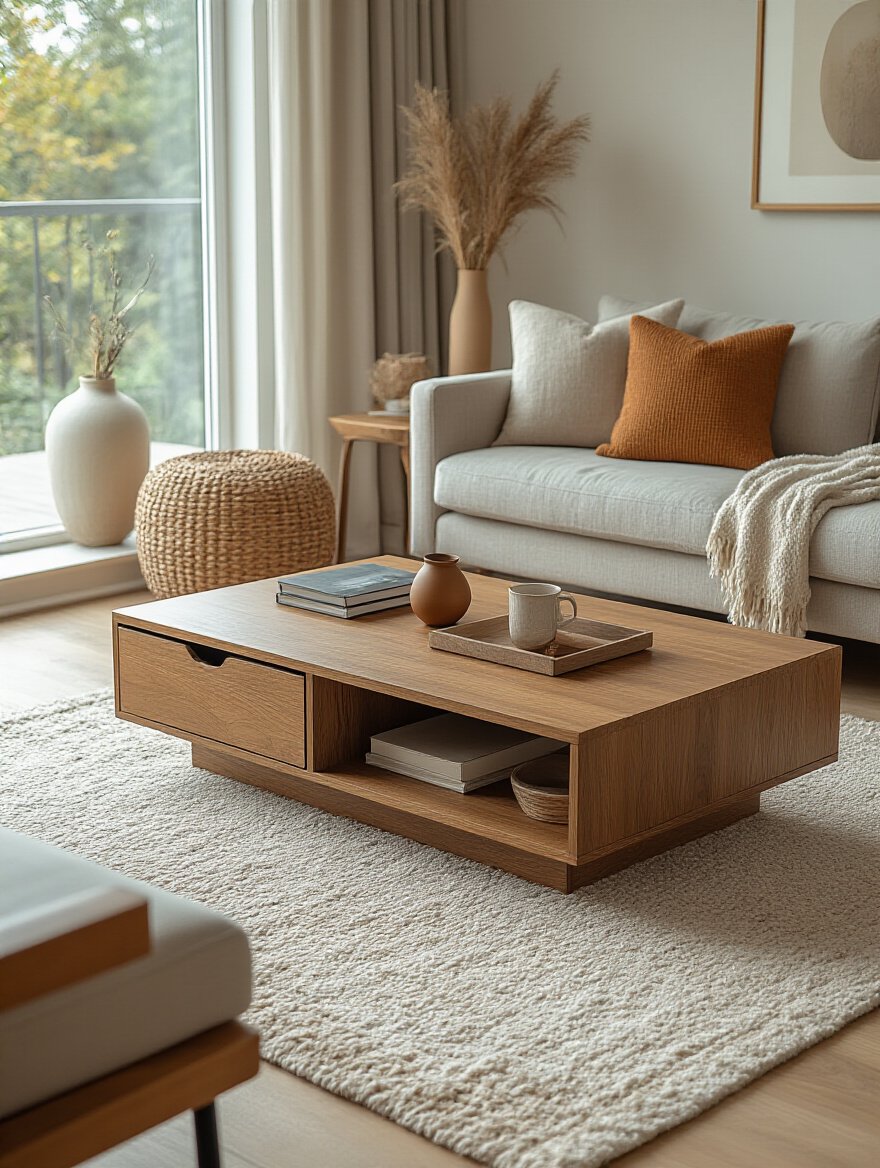
A story I love: a client with a tiny apartment used a set of two nesting tables. Most of the time, they were tucked together, a compact surface for a plant and a book. But when friends came over, she could pull the smaller one out and slide it next to an armchair, instantly creating a second surface for drinks. That’s the shortcut: think in terms of flexible surfaces, not a single, static table. This adaptability is the key to a small space feeling generous.
Now let’s bring in some supporting players to round out the seating arrangement.
Think of your accent chairs as specimen plants. They are where you can afford to be bold and a little dramatic. While your sofa might be a safe, neutral workhorse, the accent chair is your chance to introduce a sculptural shape, a rich color, or a compelling texture like bouclé or worn leather. It adds a layer of personality without the massive commitment of a whole sofa.

The biggest secret weapon here? The swivel chair. Especially in an open-concept space, a pair of swivel chairs can effortlessly pivot from a conversation with the sofa to watching the television or facing the fireplace. It’s the ultimate tool for a flexible layout, allowing a single seating group to serve multiple functions without moving a single piece of furniture. It’s the kind of quiet functionality that makes a room feel intelligently designed.
Speaking of TV, let’s get its support system right.
Picture this: a beautiful room, thoughtfully designed… with a chaotic rat’s nest of black cables spilling out from behind the TV. It’s visual static, and it completely undermines any sense of calm you’re trying to create. A good media console is less about the TV and more about masterful concealment. Look for units with built-in cutouts, ventilated backs, and deep drawers to hide the clutter.

But the biggest crime is placement. People insist on hanging their TVs way too high, especially over a fireplace. This is an ergonomic nightmare that will literally give you a pain in the neck. Here’s the rule: the center of your screen should be at eye-level when you are seated. This usually means the console will be relatively low. Don’t sacrifice your comfort for a symmetrical look that doesn’t actually work for the human body.
Finally, we need to ensure all these pieces exist in harmony.
I once walked into a client’s loft apartment. It had soaring 15-foot ceilings, and in the middle of it was a sad, low-profile sofa that looked like a toy. The scale was completely off. The room was dominating the furniture. The opposite is just as bad: a tiny room crammed with an overstuffed sectional feels suffocating. This is all about “visual weight.”

It’s not just about size; it’s about how heavy a piece feels. Dark colors and solid shapes feel heavy. Light colors and open, leggy forms feel light. To create balance, you need a mix. If you have a big, solid sofa, balance it with an airy, glass-and-metal coffee table. If your ceilings are high, you need vertical elements—a tall bookshelf, floor-to-ceiling curtains, or a towering plant like a Dracaena—to draw the eye up and match the scale of the architecture. A room with balanced scale just feels right, calm and settled.
With the heavy lifting done, we can add the layers that transform a functional space into an enchanting one. These are the elements that engage the senses, add depth, and introduce the kind of personal touches that tell your unique story.
Can we please put an end to the tiny rug epidemic? A small rug floating in the middle of a room, with all the furniture sitting apologetically around it, makes the whole space feel disjointed and smaller. It’s the single most common mistake I see. A rug is not a doormat; it is the foundation for an entire “zone.”

Here is the unbreakable rule: an area rug must be large enough so that at least the front two legs of every piece of seating in the grouping can rest comfortably on it. This simple act physically and visually tethers everything together, creating a unified, intentional island of comfort. In an open-concept space, a generously sized rug is the clearest and most effective way to say, “This is the living area,” without building a single wall.
With the ground plane defined, let’s look up.
Your walls are not just there to hold up the ceiling; they are prime real estate for storage and life. Going vertical with bookshelves is the single best way to maximize a small footprint, but I want you to think of them as more than just storage. I see them as a trellis for your life. They’re a place to weave together books, treasured objects, and, most importantly, living plants.

A vining Pothos or Philodendron cascading down from a high shelf adds instant life and movement, drawing the eye upward and making the room feel taller. Don’t just line up books spine-out. Create pockets of space. Lay some books flat to create a pedestal for a small object or a trailing Hoya. Mix in baskets to hide unsightly clutter. A well-styled shelf is a vertical garden of your personal story.
Next, we sprinkle in the small surfaces that make life more convenient.
You’re settled into your favorite chair, engrossed in a book, and you have nowhere to put your tea. It’s a small annoyance, but these little functional frictions build up and make a room feel unwelcoming. Every single seat should have a convenient surface within arm’s reach. That’s the mission of the occasional table.

The superstar of this category is the C-table. This clever little piece has a base that slides right under your sofa or chair, cantilevering a small tabletop over your lap. It’s the perfect, space-saving solution for a laptop, a snack, or a drink. It’s one of those small, smart investments that dramatically improves the daily livability of a room, providing function exactly where you need it, when you need it.
For even more utility, we can choose pieces that are true transformers.
In a world of smaller homes and multifaceted lives, every piece of furniture should be able to do more than one job. A storage ottoman is the classic example—it’s a footrest, extra seating, a coffee table, and a toy chest all in one. But we can think even bigger. A well-made sofa bed can make a living room a truly functional guest suite. A console table behind a sofa can double as a slim desk for checking emails.

But here’s the crucial warning: beware of multifunctional pieces that do two things poorly. A flimsy, uncomfortable sofa bed isn’t a solution; it’s a problem. The key is to invest in quality engineering. The transformation should be smooth and easy, and each function should be just as good as a dedicated, single-purpose piece. When done right, this approach doesn’t just save space; it makes a room brilliantly adaptable to the ebb and flow of modern life.
Let’s talk about adding a deeper layer of sensory experience.
So much of modern furniture feels flat and sterile. It’s all smooth, mass-produced surfaces. To create a room that feels rich and alive, you need to introduce texture. This is a core principle of biophilic design—the idea that our well-being is enhanced by connections to nature. Think beyond basic wood and fabric.

Consider the rough, cool surface of a concrete coffee table, the fuzzy, comforting embrace of a bouclé chair, the organic pattern of a rattan cabinet, or the smooth, cool feel of a petrified wood side table. These materials engage your sense of touch and add a layer of visual complexity that is deeply satisfying. The secret is to create contrast: pair a rough texture with a smooth one, a soft with a hard. This interplay of materials is what gives a room soul.
To see all these beautiful textures, we need the right light.
A single, harsh overhead light is the fastest way to kill the mood of any room. It casts unflattering shadows and makes everything feel flat and sterile. Great lighting is about creating layers, just like in a forest where you have the bright canopy, the dappled mid-story, and the shady forest floor. Your living room needs at least three layers of light.

This layered approach gives you total control over the mood. You can switch from bright and functional for cleaning to low and cozy for relaxing. Proper lighting is not an accessory; it is one of the most powerful tools for shaping the emotional experience of your space.
Now we move into the realm of true curation. This is where you infuse your space with a deep sense of personal history and conscious choice, creating a room that will not only last but also evolve beautifully with you over time.
Anyone can buy a new media console from a big-box store. It takes a bit of a hunt to find a 1960s Danish teak credenza, and that hunt is part of the story. Vintage pieces are not just furniture; they are artifacts. They possess a soul, a patina, and a quality of construction that is often impossible to find in new items at a comparable price.

Integrating one or two vintage pieces is the fastest way to prevent your room from looking like a page in a catalog. Don’t worry about everything matching perfectly. In fact, it’s better if it doesn’t. A vintage piece should stand out as a special find. It adds a layer of history and proves that your style is curated, not just purchased. Plus, it’s the ultimate act of sustainable design—giving a beautiful, well-made object a second life.
This idea of a second life also applies to the layout itself.
Your life is not static, so why should your living room be? A family grows, hobbies change, and you might work from home one day. Designing for flexibility means your space can adapt without a complete, costly overhaul. The key lies in choosing mobile, modular, and multi-functional pieces.

Instead of a single, massive sectional, consider a modular one where the pieces can be reconfigured. Use lightweight armchairs that can be easily moved. Opt for nesting tables instead of one heavy coffee table. This approach allows your room to transform with you. What is a spacious play area for toddlers today can become an intimate conversation nook for teenagers tomorrow, all with the same core furniture.
Part of planning for the future means choosing materials that can handle it.
There is nothing less relaxing than living in fear of your own furniture. If you have kids, pets, or just enjoy a glass of red wine on the sofa, then delicate fabrics like silk or unprocessed linen are a source of constant anxiety. Thankfully, fabric technology has come to our rescue with “performance fabrics.”

Brands like Crypton, Sunbrella, and Revolution have created textiles that are virtually indestructible. They are engineered at the molecular level to repel stains, resist fading, and withstand incredible amounts of wear (look for a “double rub” count of over 30,000 for high-traffic pieces). This isn’t a compromise; it’s freedom. The freedom to actually live in your living room without stress, which is, after all, the entire point.
Let’s take that conscious choice a step further.
What if your furniture could not only look good but also contribute to a healthier planet and a healthier you? That’s the promise of sustainable furniture. It’s about choosing pieces made from responsibly sourced materials, like wood certified by the Forest Stewardship Council (FSC), which ensures it comes from well-managed forests.

Even more importantly, it’s about what’s not in the furniture. Conventional furniture can off-gas volatile organic compounds (VOCs) from glues, foams, and finishes, polluting your indoor air. Look for certifications like GREENGUARD Gold, which guarantees low chemical emissions. This isn’t just an abstract environmental choice; it’s a direct investment in the health of your home’s ecosystem and the quality of the air you breathe every day.
Finally, let’s learn to work with the unique ecosystem you already have.
Your home may have a story already built into its bones—a beautiful fireplace, a big bay window, or interesting built-in shelves. These are not obstacles to be designed around; they are gifts to be celebrated. The most common mistake is to ignore or, even worse, block them. Don’t put the sofa in front of the stunning window; frame the window with two chairs to create a sun-drenched reading nook.

Arrange your primary seating to face the fireplace, making it the undeniable heart of the room. This makes your design feel intentional and deeply connected to the space itself. You’re not just placing furniture in a box; you’re having a conversation with the architecture. This simple act of honoring the room’s inherent character is the final touch that makes a space feel truly bespoke and settled.
So, there you have it. Building your dream living room isn’t a shopping spree; it’s an act of cultivation. It begins with understanding the environment and ends with a space that is not only beautiful but also resilient, adaptable, and deeply supportive of the life you want to live.
Think of yourself not as a decorator, but as the patient gardener of your own home. Observe the light, understand the flow, and choose pieces that will grow with you. Let your home be a living testament to what you value—be it connection, tranquility, or creativity. By weaving together purpose, personality, and a few well-tended plants, you can create an ecosystem where you don’t just reside, but truly, deeply, thrive.